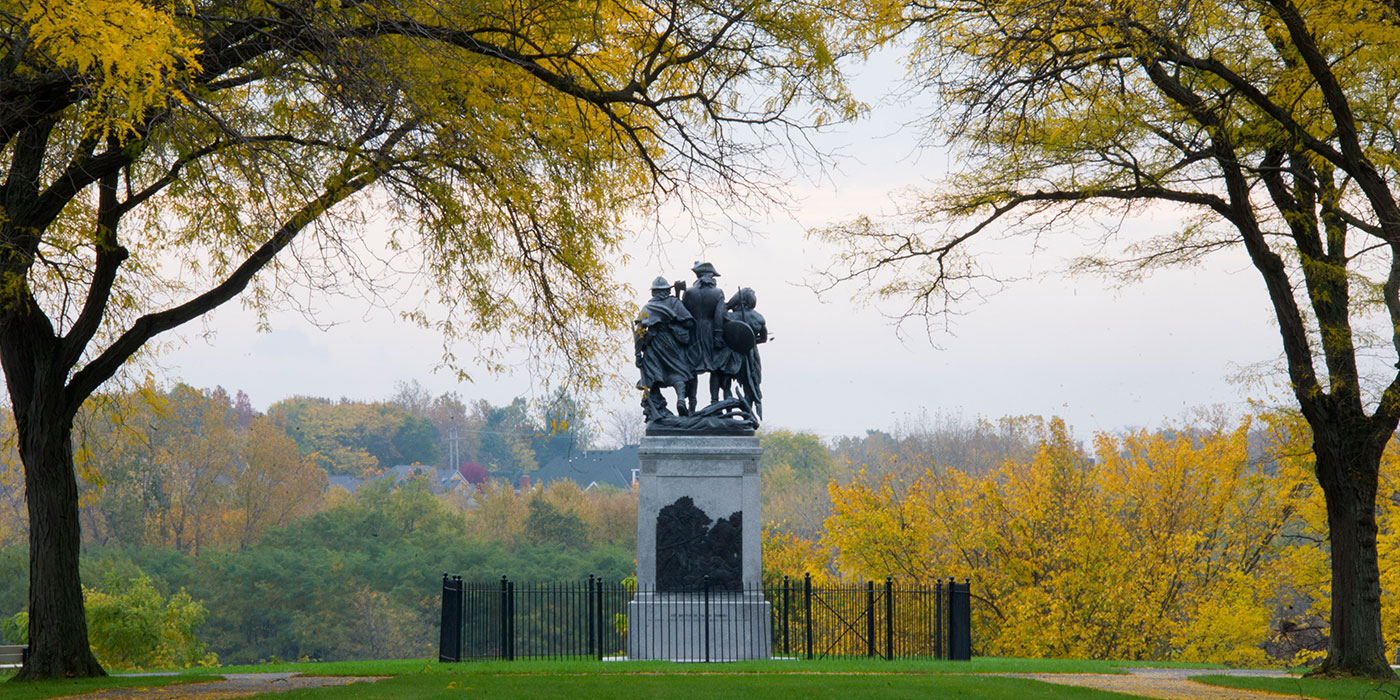
Battlefield Site History
A Land Worth Fighting For
This Maumee River Valley offered fertile hunting and farm grounds that nurtured the Native American’s lifestyle for of thousands of years. Archaeological studies have found artifacts from the Woodland Indian period (500 BC to 1100 AD) near the Maumee River and floodplains. These artifacts help paint a picture of a people who not only hunted and gathered on the banks of the Maumee but also had homes and crops. As Europeans settled in the area for the lucrative fur trade their influence on Native Americans could be seen through trade silver, clothing and weaponry. However, it would not be until American settlers began pushing into the Northwest Territory, and claiming Native American land that true culture clashes began.
Culture Clashes Lead to War
During the Revolutionary War, many Native American Nations sided with the British, this would later prove problematic to the Native Nations during the Treaty of Paris negotiations. The Treaty of Paris in 1783 seceded British held lands in the Northwest Territory, including Ohio, to the newly formed United States. The U.S. viewed Great Britain as proper negotiators on the behalf of the Nations—this however failed to account for the fact that tribes viewed themselves as independent nations not beholden to the British, French or Americans—nor even to other Native American Nations.
As American settlers started to push into historically Native lands, clashes erupted. Natives did not recognize the settlers’ claim to land ownership as they had not been fairly treated with. To combat the settlers pushing further into their homelands, a formidable fighting force of Native Americans formed. This inter-tribal alliance—the Western Confederacy—included members from across the entire Great Lakes Region. Members of the Wyandot, Delaware, Chippewa, Ottawa, Potawatomi, Mingo, Shawnee, Miami, Kickapoo, and other tribes joined this alliance. Leaders included Chiefs Little Turtle (Myaamia), Tarhe (Wyandotte) Blue Jacket (Shawnee), and Buckongahelas (Delaware). Those tribes that contributed the most warriors were Wyandot, Miamis, Shawnees, Ottawa and Delaware. To halt the hostilities between settlers and Native Americans, President Washington sent soldiers into the Northwest Territory to restore peace. Two failed attempts by Generals Harmar and St. Clair, would call General Anythony Wayne from retirement to lead a newly formed Legion of the United States in 1792.
Battle of Fallen Timbers
On July 28, 1794 the Legion began their march toward Miamis River Valley (modern day Maumee River Valley) from Greeneville. By August 18th, they had reached Roche de Bout at the lower rapids of the Maumee River. Wayne’s troops now approximately numbered 3,000. At around the same time, just below Fort Miamis, three Native villages still remained at the mouth of Swan Creek. These villages were receiving an influx of Native warriors. The Shawnee, Ottawa, and Delaware villages were joined by defenders from the Upriver Miami & Shawnee, the North Chippewa, Ottawa, and Potawatomi and the Wyandots from the Sandusky Valley. On August 19, 1,300 warriors marched to the most advantageous ground near Ford St. in modern Maumee to wait and prepare for battle. At the same time, Wayne’s men were building Fort Deposit at Roche de Bout, site if modern day Farnsworth Metropark.
Fort Deposit was hastily constructed and, on the morning of August 20, 1794, rain delayed the start of the Legion’s march. Wayne had hoped to start marching at 5am, but didn’t get started until 7am. Also important to note for the Legion was the loss of communication. The drums used to signal troop movements were not functioning due to the rain. So orders were passed by men between Wayne, Wilkinson and Hamtramck. One soldier’s account noted that the Legion marched nearly 4 miles without hindrance—before shots from the forward guard rang out.
Several miles downstream, the Western Confederacy formed its line (about ½ mile in advance of its position the day before). According to Alexander McKee, British Indian Agent, more than 800 warriors were in advance while 300 were in a defensive position, which extended at an oblique angle (with their right flank advanced). This would have been a defensive position on the high ground leaving the prairie floodplain unoccupied. On the far right of the flank were 100 Wyandot, an unidentified number of British and 60 of the Queen Rangers (Canadians). To the left were the Mingo, Delaware, Shawnee, Potawatomi, Ottawa and the Chippewa extending to the river’s bluff.
The sustained fire from the Legion prevented a quick and decisive victory (like those the Natives had already won in 1790-1791). 400 warriors were now spread out in skirmish lines facing 1,000 well- armed regulars on the right flank lead by General George Wilkinson. These warriors were pushed from their original positions and eventually left the battle. The Legion was able to then move forward with little resistance until they encountered the Wyandots, who were still engaged in battle with General Hamtramck’s left line. The Wyandots were the last to leave the battlefield—forced out by superior numbers and several hundred militia who began to close in on their flank. They continued to fight, killing two more officers but suffering devastating losses. Wyandot Chief Crane along with 8 other principle chiefs and 20 warriors were killed alongside 6 British allies. The organized resistance collapsed as the Wyandot’s fell. The entire battle took less than two hours—with direct engagement lasting about 45 minutes.
Treaty of Greenville
The loss at fallen timbers left the Native Confederacy divided. The Nations who had villages along the Maumee River had little to no food or shelter left after Wayne’s Legion destroyed it all on their way back to Cincinnati. The British were illegally occupying Detroit and the newly-constructed Fort Miamis and at war with France. They could little afford to start a war on two fronts by openly supporting the Confederacy. Hence their refusal to give aid to the Confederacy after the Battle of Fallen Timbers—effectively destroying any remaining alliance between the British and the Western Confederacy.
Several Native Nations agreed to treat with Wayne and began to arrive at Ft. Greenville by the official start on June 16, 1795. Negotiations and heated speeches continued through July 30th with points at which the peace process looked doomed. But boundary lines were finally agreed to August 3.
In the treaty, tribes retained northwest Ohio as Indian land, except for several reserves granted to the United States. One was a 12-mile square, surrounding the foot of the rapids, where military and trading activities led to early settlement of Maumee and Perrysburg. The treaty officially ended the Indian Wars and drew a line for US settlement nearly as far north as the Maumee River.
